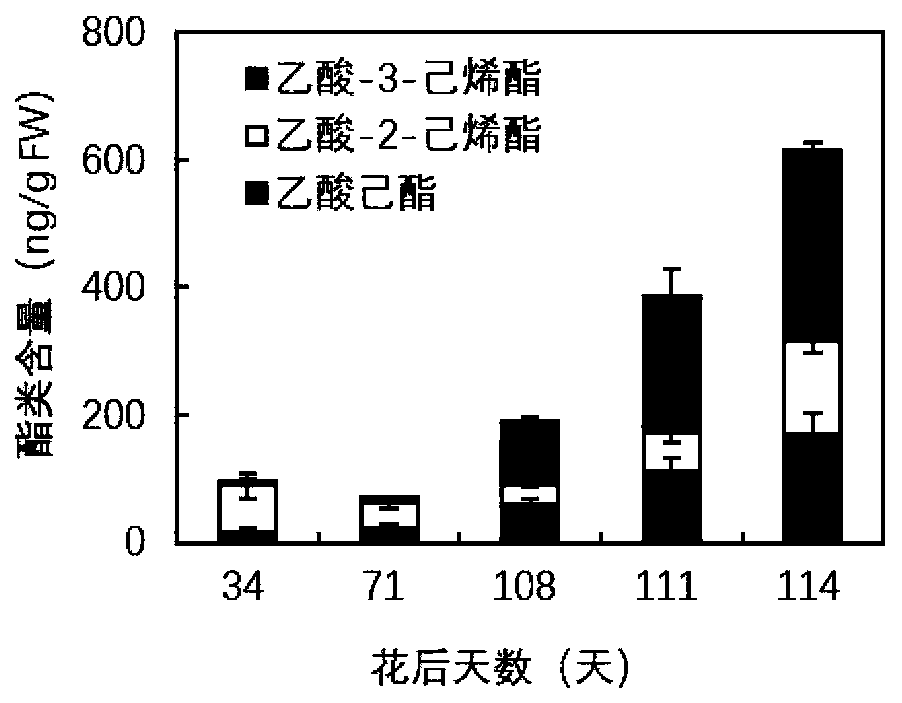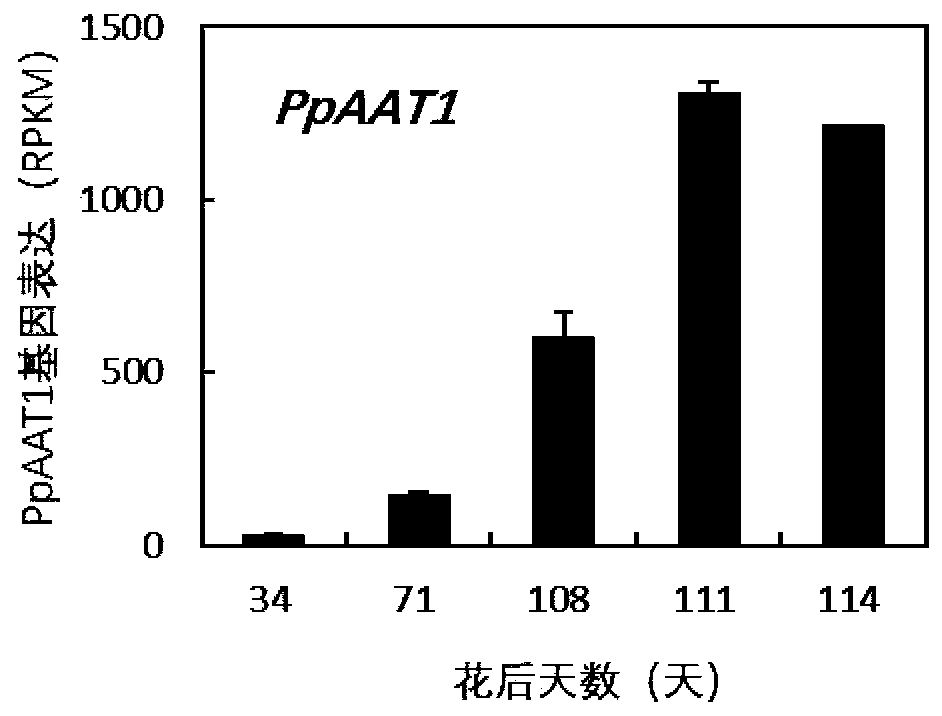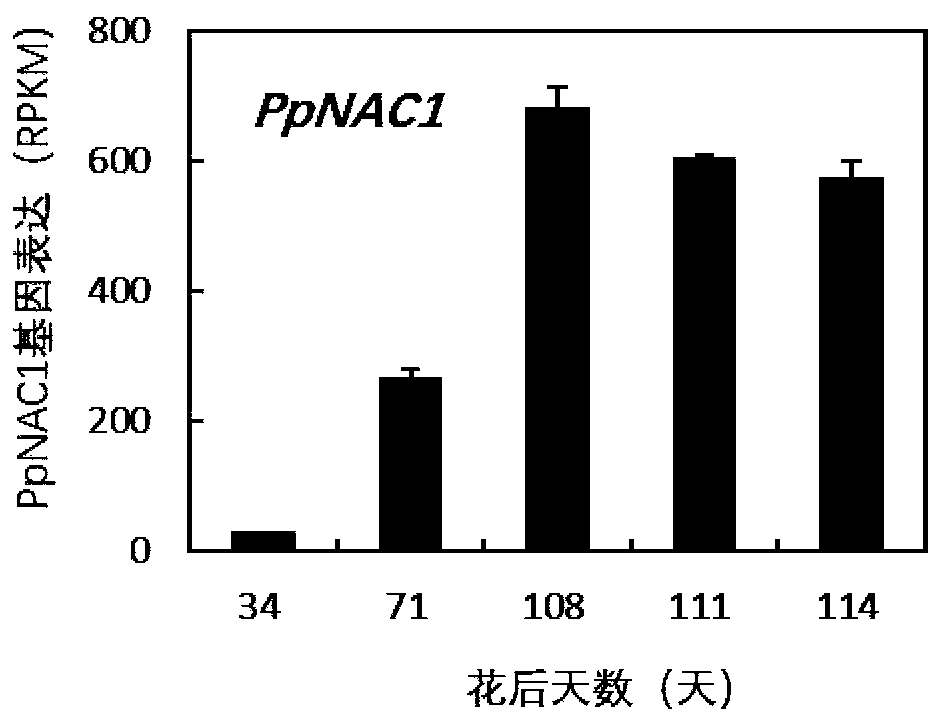Transcription factor PpNAC1 participating in synthesis regulation of peach ester aromatic substances and application of transcription factor PpNAC1
A technology for transcription factors and aromatic substances, which is applied in the field of plant molecular biotechnology and genetic engineering, and can solve the problems of unclear transcriptional regulation mechanism and few transcription factors.
- Summary
- Abstract
- Description
- Claims
- Application Information
AI Technical Summary
Problems solved by technology
Method used
Image
Examples
Embodiment 1
[0043] Example 1 Expression of PpNAC1 and PpAAT1 in peach fruit and detection of volatile esters content (1) Experimental method
[0044] 1. Peach fruit material
[0045] Lakeview honeydew fruits collected from Juicy Peach Research Institute in Fenghua City, Zhejiang Province in five different growth and development stages: S1 (34 days after flowering, young fruit stage), S2 (71 days after flowering, swelling stage), S3 (flowering After 108 days, maturity stage), S4 (placed at 20°C for 3 days after ripening), S5 (placed at 20°C for 6 days after ripening), the pulp tissue was frozen in liquid nitrogen and stored at -80°C. Three biological replicates were set up at each sampling time point, and each replicate had 5 fruits.
[0046] 2. RNA extraction and transcriptome sequencing
[0047] Add 1 g of the sample thoroughly ground by liquid nitrogen into a centrifuge tube with 4 mL of CTAB / β-mercaptoethanol extraction buffer preheated at 65 °C, vortex and mix, and bathe in water at...
Embodiment 2
[0052] Example 2 Verification of the transcriptional activation effect and NAC binding site of PpNAC1 by tobacco dual luciferase
[0053] (1) Experimental method
[0054] 1. cDNA synthesis and DNA extraction
[0055] Take 1.0 μg of total fruit RNA, remove the genomic DNA with the TAKARA kit, and synthesize cDNA by reverse transcription according to the instructions. The genomic DNA of peach fruit was extracted by CTAB method. Add 1 g of peach fruit material ground by liquid nitrogen, add 4 ml of CTAB / β-mercaptoethanol extract solution preheated at 65 °C, vortex and mix, and bathe in 65 °C water for 1 h; add 4 ml of chloroform / isoamyl alcohol (24:1), Vortex and mix well; centrifuge at 10,000rpm at 15°C for 10min, take the supernatant, add 2ml of 5M sodium acetate, 4ml of isopropanol pre-cooled at -20°C, mix by inverting and place at -20°C for 1h; centrifuge at 12,000rpm for 15min, discard The supernatant; the precipitate was washed twice with 1ml of 75% ethanol, the supernat...
Embodiment 3
[0062] Example 3 EMSA verification of the binding effect of PpNAC1 and PpAAT1-promoter
[0063] (1) Experimental method
[0064] 1. Construction of recombinant vectors and transformation of expression strains
[0065] Combining the primer pair of SEQ ID NO.20 and SEQ ID NO.21, the PpNAC1 DNA binding Domain fragment (N-terminal 480bp) was obtained by PCR amplification, and constructed in pGEX-GST digested by EcoR I and Xho I by homologous recombination The vector was transformed into DH5α and confirmed by sequencing, and then transformed into Escherichia coli expression strain BM Rosetta (DE3), and positive clones were picked and saved.
[0066] 2. Induced expression and purification of recombinant protein
[0067] The transformed BM Rosetta (DE3) bacteria were cultured in 20 mL of LB containing AMP (100 mg / L) for 12 h, and then transferred to 500 mL of LB containing AMP (100 mg / L) at a ratio of 1:50 to continue culturing until OD600=0.6, adding IPTG (final concentration 0.5...
PUM
 Login to View More
Login to View More Abstract
Description
Claims
Application Information
 Login to View More
Login to View More - Generate Ideas
- Intellectual Property
- Life Sciences
- Materials
- Tech Scout
- Unparalleled Data Quality
- Higher Quality Content
- 60% Fewer Hallucinations
Browse by: Latest US Patents, China's latest patents, Technical Efficacy Thesaurus, Application Domain, Technology Topic, Popular Technical Reports.
© 2025 PatSnap. All rights reserved.Legal|Privacy policy|Modern Slavery Act Transparency Statement|Sitemap|About US| Contact US: help@patsnap.com



